
Canning is a village in northeastern Kings County, Nova Scotia located at the crossroads of Route 221 and Route 358.
Palaeophonus is the oldest known genus of scorpions.

The South African National Roads Agency SOC Ltd or SANRAL is a South African parastatal responsible for the management, maintenance and development of South Africa's proclaimed National Road network which includes many National ("N") and some Provincial and Regional ("R") route segments.
Dutoitia is a genus of Devonian rhyniophyte, named after the renowned South African geologist Alex du Toit. It is one of the earliest plants from Gondwana to colonize land. Its fossils were preserved in fine mudstones of the 400-million-year-old Bokkeveld and Witteberg Groups of South Africa. This erect, gracile plant is less than 10 cm high and very simple in structure. Its diminutive stems, which are devoid of leaflike appendages, branch in two and end in club- or cup-shaped sporangia, occasionally containing its reproductive spores. Stomata are present in the cuticle of their stems for gas exchange, and primitive cells inside the stems transported water from the roots to the aerial parts of the plant. Three species are recognized, D. pulchra Hoeg 1930, D. alfreda Plumstead 1967 and D. maraisia Plumstead 1967.

Lieutenant Harold Lothrop Borden was from Canning, Nova Scotia and the only son of Canada's Minister of Defence and Militia, Frederick William Borden and related to future Prime Minister Robert Laird Borden. Serving in the Royal Canadian Dragoons, he became the most famous Canadian casualty of the Second Boer War. Queen Victoria asked F. W. Borden for a photograph of his son, Prime Minister Wilfrid Laurier praised his services, tributes arrived from across Canada, and in his home town a monument was erected to his memory.
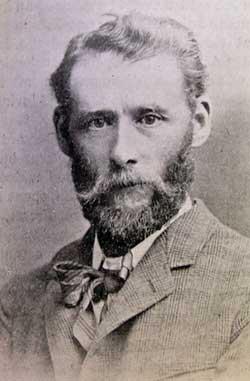
Hamilton Thomas Carlton Plantagenet MacCarthy was one of the earliest masters of monumental bronze sculpture in Canada. He is known for his historical sculptures, in particular his Pierre Dugua, Sieur de Mons at Annapolis Royal, Nova Scotia (1904) as well as Samuel de Champlain overlooking Parliament Hill on Nepean Point, Ottawa (1915), next to the National Gallery of Canada. His monument to the Ottawa volunteers who died in the South African War (1902) was moved to Confederation Park in 1969 after several moves. Other works include that of Ottawa mayor, Samuel Bingham, in Notre-Dame Cemetery in Vanier.
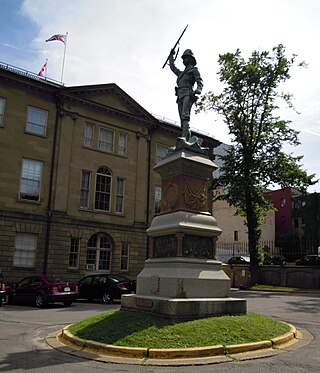
The South African War Memorial is a memorial located in the courtyard of Province House in Halifax, Nova Scotia, Canada.
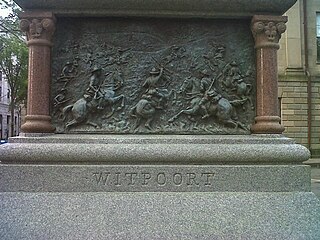
The Battle of Witpoort was a battle during the Second Anglo-Boer War. Major Frederick Henry Munn commanded the detachment of the Royal Irish Fusiliers at Witpoort which was attacked on 16 July 1900, his orders being to "hold his position at all costs". The Boers called on Major Munn to surrender, but, scornfully refusing, he held out from daybreak till 2 pm, when the Canadian forces mounted a counterattack and the Boers retired. The battle became famous because of the death of Harold Lothrop Borden.
Witpoort is a town in Dr Kenneth Kaunda District Municipality in the North West province of South Africa.

Gondwanascorpio emzantsiensis is an extinct Gondwanan scorpion that lived 360 million years ago in the Devonian. Its fossil remains, clearly showing pincer and sting, were discovered in rocks of the Witteberg Group near Grahamstown in South Africa. At present, this scorpion is the oldest known land-dwelling animal from Gondwana, which in Devonian times was separated from Laurasia by a deep ocean. At the time, the fossil site was only 15° from the South Pole, but rather than arctic-like tundra, the region was probably wooded, providing ample insect life for food. Previously, only two scorpion species were known from the late Devonian – Hubeiscorpio gracilitarsus from China and Petaloscorpio bureaui from Canada. The species was described by Robert Gess of Wits University in the journal African Invertebrates. The specific epithet derives from umZantsi, the isiXhosa word for "south", sometimes used for South Africa.
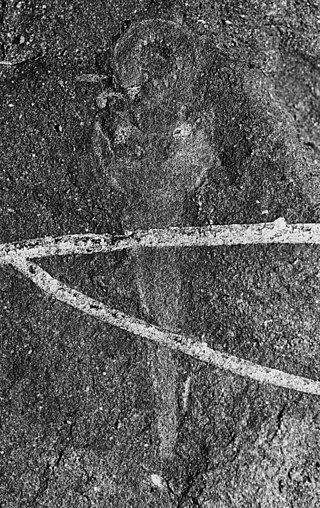
Priscomyzon riniensis is an extinct lamprey that lived some 360 million years ago during the Famennian in a marine or estuarine environment in South Africa. This small agnathan is anatomically similar to the Mazon Creek lampreys, but is some 35 million years older. Its key developments included the first known large oral disc, circumoral teeth and a branchial basket.

Antarctilamna is an extinct genus of Devonian shark originally exemplified by Antarctilamna prisca from South Eastern Australia and Antarctica. The latest occurring described species is Antarctilamna ultima from the Waterloo Farm lagerstätte in South Africa. Antarctilamna has robust ctenacanthid-like spines which lack a deep insertion area, and are borne in front of the first dorsal fin; in addition to distinctive diplodont teeth with small intermediate cusps. Antarctilamna-like spines, known from the Bunga Beds locality in Australia have been ascribed to A. prisca.
Africanaspis is an extinct genus of groenlandaspidid placoderm known from two species, Africanaspis doryssa, named in 1997 from fossils discovered in South Africa and Africanaspis edmountaini, named from fossils described from South Africa during 2017. A. edmountaini is only known from juvenile specimens. Both species are known from the Witpoort Formation.
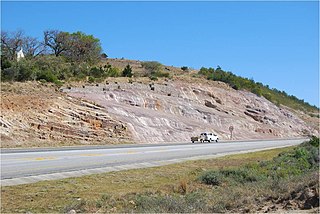
The Waterloo Farm lagerstätte is a Famennian lagerstätte in South Africa that constitutes the only known record of a near-polar Devonian coastal ecosystem.
Hexachara is a genus of fossil charophyte that is likely to have formed meadows within sheltered oligohaline reaches of lakes.
Isityumzi mlomomde is a weakly described fossil lungfish based on one complete parasphenoid, tooth plates fragments and scales from the Late Devonian Sarcopterygians. It represents the only record of Late Devonian lungfish remains from western Gondwana.
Kowieria is an extinct genus of lycopsid from the Late Devonian from Waterloo Farm, containing the single species Kowieria alveoformis. As of 2021 it is being characterised as incertae sedis. It was first described in 2017 from a black shale layer interbedded with quartzite strata of the Famennian aged Witpoort Formation.

Rinistachya is a genus of Late Devonian sphenopsid, currently containing one species, Rinistachya hilleri. It comprises the only sphenopsid as yet known from the Devonian of Gondwana, and is currently known from only a small number of specimens collected from the main fish layer/lens (MFL) black shale within the Witpoort Formation at Waterloo Farm, Makhanda. It is currently interpreted as a small-sized herbaceous plant. and 'exhibits a novel architecture' that includes apparently plesiomorphic characters, reminiscent of the organisation of the Iridopteridales. Other characters unambiguously nest Rinistachya within the Sphenopsida. This provides strong support for a close relationship between Sphenopsida and Iridopteridales. It is the only known high latitude sphenopsid known from the Devonian, the only other 3 genera, Eviostachya, Hamatophyton and Rotafolia being of palaeotropical provenance.

Lorne W. R. Mulloy was a Canadian soldier, hero of the Boer War, professor at the Royal Military College of Canada, and prominent lawyer. He was blinded in both eyes at the Battle of Witpoort and was awarded the Distinguished Conduct Medal.
Lieutenant John Edgar Burch was an officer of the Canadian Militia. Serving with the 1st Canadian Mounted Rifles during the Boer War, he was killed in action at the Battle of Witpoort alongside Lieutenant Harold Lothrop Borden while leading a counter-attack on the Boer positions.













